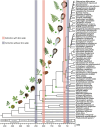Ferns as facilitators of community recovery following biotic upheaval
- PMID: 39850062
- PMCID: PMC11756664
- DOI: 10.1093/biosci/biae022
Ferns as facilitators of community recovery following biotic upheaval
Abstract
The competitive success of ferns has been foundational to hypotheses about terrestrial recolonization following biotic upheaval, from wildfires to the Cretaceous-Paleogene asteroid impact (66 million years ago). Rapid fern recolonization in primary successional environments has been hypothesized to be driven by ferns' high spore production and wind dispersal, with an emphasis on their competitive advantages as so-called disaster taxa. We propose that a competition-based view of ferns is outdated and in need of reexamination in light of growing research documenting the importance of positive interactions (i.e., facilitation) between ferns and other species. Here, we integrate fossil and modern perspectives on fern ecology to propose that ferns act as facilitators of community assemblage following biotic upheaval by stabilizing substrates, enhancing soil properties, and mediating competition. Our reframing of ferns as facilitators has broad implications for both community ecology and ecosystem recovery dynamics, because of ferns' global distribution and habitat diversity.
Keywords: ecosystem recovery; facilitation; interdisciplinary science; paleontology; plant ecology.
© The Author(s) 2024. Published by Oxford University Press on behalf of the American Institute of Biological Sciences.
Figures




References
-
- Adams AB, Dale VH, Smith EP, Kruckeberg AR. 1987. Plants Survival, Growth Form and Regeneration Following the 18 May1980 Eruption of Mount St. Helens. Northwest Science 61: 160–170.
-
- Anderson OR. 2021. Physiological ecology of ferns: Biodiversity and conservation perspectives. International Journal of Biodiversity and Conservation 13: 49–63.
-
- Arenillas I, Arz JA, Gilabert V. 2018. Blooms of aberrant planktic foraminifera across the K/Pg boundary in the Western Tethys: Causes and evolutionary implications. Paleobiology 44: 460–489.
-
- Barrington DS. 1993. Ecological and historical factors in fern biogeography. Journal of Biogeography 20: 275. 10.2307/2845635. - DOI
Publication types
LinkOut - more resources
Full Text Sources

